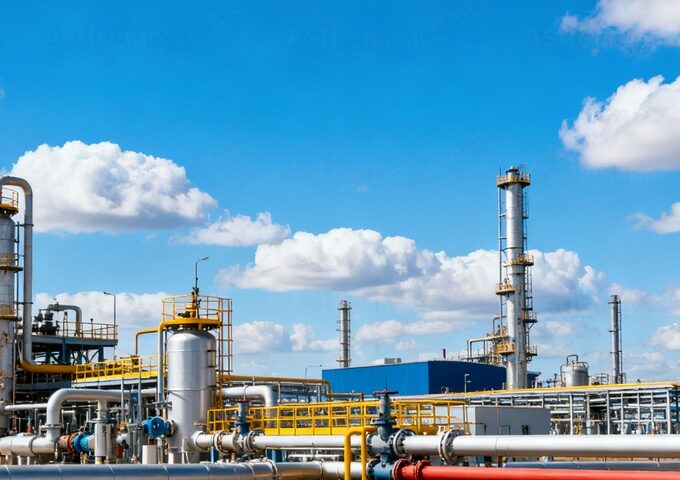Against a global push for energy transition and climate change mitigation, hydrogen energy has emerged as a clean, efficient, and sustainable energy carrier, gradually becoming a focal point in the energy sector. Hydrogen combustion produces only water, emitting no greenhouse gases or pollutants, making it a core component of the future energy system. Among various hydrogen production technologies, hydrogen production from natural gas stands out for its unique advantages. It is expected to maintain a crucial role in the hydrogen industry for the foreseeable future.
Principles and Processes of Hydrogen Production from Natural Gas
Steam Methane Reforming (SMR)
Steam methane reforming is currently the most widely used method for producing hydrogen from natural gas, accounting for over 70% of total hydrogen production. The principle involves reacting natural gas (primarily methane) with steam at high temperatures (typically 700–1000°C) in the presence of a catalyst. The chemical reaction is:
CH₄ + H₂O ⇌ CO + 3H₂
This is a highly endothermic reaction, requiring substantial external heat input. The resulting carbon monoxide further reacts with steam through the water-gas shift reaction:
CO + H₂O ⇌ CO₂ + H₂
Thus increasing the hydrogen yield. SMR is a mature and reliable process capable of large-scale hydrogen production, although it is energy-intensive and produces a certain amount of CO₂ emissions.
Partial Oxidation (POX)
Partial oxidation involves the incomplete combustion of natural gas with oxygen at lower temperatures (typically 900–1100°C) to produce hydrogen. The reaction is:
2CH₄ + O₂ ⇌ 2CO + 4H₂
Compared with SMR, POX is an exothermic process and does not require external heating, allowing the use of refractory material reactors instead of expensive high-temperature alloy reactors, thus reducing capital investment. However, challenges such as the need for low-cost oxygen sources, catalyst bed hot spots, catalyst stability, and operational safety limit its industrial application.
Autothermal Reforming (ATR)
Autothermal reforming combines the advantages of SMR and POX. In this process, natural gas reacts simultaneously with steam and oxygen (or air), with the exothermic heat from partial oxidation providing the necessary energy for steam reforming, achieving thermal balance. The reaction system is complex, involving multiple coupled chemical reactions. ATR allows hydrogen production at relatively lower temperatures with higher energy efficiency and lower pollutant emissions. Nevertheless, challenges include maintaining catalyst activity and stability under harsh conditions and the need for equipment capable of withstanding high temperatures and pressures.
Advantages and Challenges of Hydrogen Production from Natural Gas
Advantages
- Abundant Feedstock: Natural gas is a widely available fossil resource with a stable global supply, providing a solid foundation for large-scale hydrogen production. Regions like the Middle East, rich in natural gas reserves, have a strategic advantage in developing natural gas-based hydrogen industries.
- Relatively Low Cost: Among existing hydrogen production methods, natural gas reforming offers comparatively lower costs due to stable natural gas prices and the maturity of SMR technology. In regions with abundant natural gas, hydrogen production costs can be as low as $1 per kilogram.
- Mature Transportation and Storage Infrastructure: Natural gas benefits from an established pipeline transportation and storage network. During hydrogen production, existing natural gas pipelines can be used to transport feedstock, and hydrogen can be partially blended with natural gas for distribution, reducing standalone hydrogen transport costs.
Challenges
- Carbon Emissions: Although natural gas reforming emits less CO₂ than coal-based hydrogen production, it still results in notable emissions. Achieving carbon neutrality requires the implementation of carbon capture and storage (CCS) or carbon capture, utilization, and storage (CCUS) technologies, which add to costs and technical complexity.
- Catalyst Performance Bottlenecks: Catalysts play a vital role in all natural gas reforming processes. Common catalysts, such as nickel-based ones, are prone to coking and sintering at high temperatures, reducing efficiency and stability. High-performance catalysts like noble metals are costly, limiting large-scale applications. Thus, developing low-cost, high-performance, and durable catalysts is a critical research direction.
- High Equipment Requirements: Some reforming processes operate under high-temperature and high-pressure conditions, requiring specialized materials and equipment. This increases manufacturing, maintenance, and operational costs and introduces additional safety risks.

Research Progress in Natural Gas-Based Hydrogen Production
Breakthroughs Under Mild Conditions: The Institute of Engineering Thermophysics, Chinese Academy of Sciences, achieved a significant breakthrough by demonstrating “net-zero emission” hydrogen production from natural gas at a mild temperature of 400°C. By orderly separating hydrogen and CO₂, they reduced the traditional reaction temperature from 800–1000°C to below 400°C, achieving over 99% methane conversion to high-purity hydrogen and CO₂ while lowering energy consumption for hydrogen production and decarbonization by 20–40%. Over 6000 stable operational cycles validated the method’s reliability and industrial application potential, paving a new path for energy-efficient, low-emission natural gas hydrogen production.
Application of Oxygen-Permeable Membrane Technology: The U.S. Department of Energy has focused on developing Integrated Oxygen Transport Membrane (ITM) hydrogen production technology. ITM uses high-temperature ceramic membranes to integrate oxygen production with catalytic partial oxidation of natural gas. Preliminary evaluations suggest that this method could reduce capital costs by approximately 25% and production costs by 30–50% compared to conventional processes. Similar research by Dalian Institute of Chemical Physics, University of Science and Technology of China, and Nanjing University of Technology has shown that the prepared membranes meet application requirements for oxygen flux and stability, offering a solution to the challenge of affordable oxygen supply in POX processes.
Applications and Future Prospects of Hydrogen Production from Natural Gas
Application Areas
- Transportation: Hydrogen serves as a zero-emission fuel for fuel cell vehicles (FCVs) with long range and short refueling times. On-site hydrogen production from natural gas at refueling stations can lower costs and logistical challenges during the early stages of hydrogen infrastructure development.
- Industrial Use: Hydrogen is vital in industries like chemicals, steel, and metallurgy, supporting processes such as ammonia synthesis, methanol production, and direct iron reduction. Natural gas-based hydrogen offers a stable and cost-effective supply for these sectors.
- Distributed Energy Systems: Combining natural gas and hydrogen production with distributed energy systems allows localized generation and utilization, particularly in remote areas requiring high energy supply reliability.
Future Outlook
In the short term, industrial by-product hydrogen production cannot fully meet the growing demand, while renewable-based electrolysis remains costly and limited by energy supply stability. Therefore, natural gas-based hydrogen production will continue to serve as a crucial transitional solution. In the medium to long term, ongoing advancements in CCS/CCUS and catalyst development will reduce emissions and costs, while integration with renewable-based hydrogen will offer flexibility, creating a diverse, efficient, and clean hydrogen supply network. In terms of policy, governments of various countries have successively introduced policies to encourage the development of the energy industry to promote energy transition and address climate change. These policies will provide strong support for the research and development, demonstration, and commercial application of hydrogen production technology from natural gas, and promote the healthy development of the hydrogen production industry from natural gas.
Despite the challenges, hydrogen production from natural gas holds immense promise. With sustained technological innovation, supportive policies, and industrial collaboration, it is poised to make a significant contribution to building a low-carbon, sustainable energy future.












